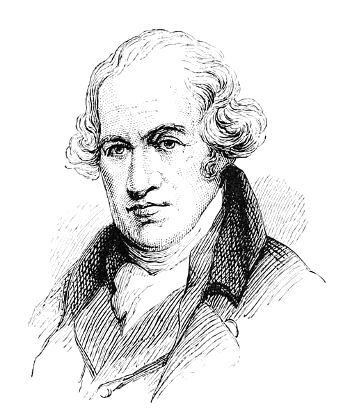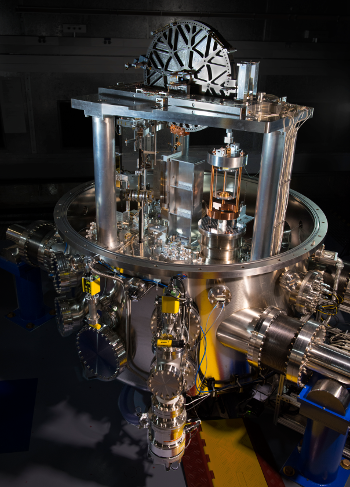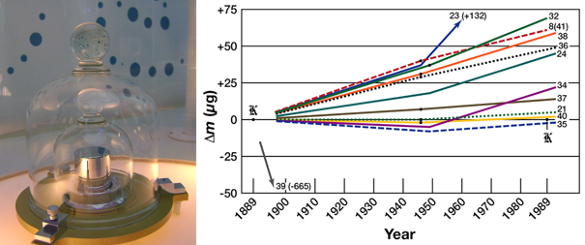The Planck Constant and the Kilogram
July 21, 2016
James Watt, perfecter of the
steam engine, is remembered by the
unit for
power, the
watt. The watt was named the unit of power by the Second Congress of the
British Association for the Advancement of Science in 1889. It was adopted into the
International System of Units as an "SI" unit in 1960 by the 11th
General Conference on Weights and Measures. I wrote about steam engines in an
earlier article (Steam Power, January 28, 2011).
In Watt's time,
horses were the
engines of many
industries, and the unit of power was the
horsepower, so it was natural that Watt would compare the power of his steam engines to the lifting power of
draft horses. To do this with any measure of
accuracy, you would need to test many horses.
statistically, one percent accuracy
would require 10,000 horses. Today's standards equate a horsepower with 745.7 watts, although the
nameplate horsepower on
electric motors uses a
rounded value of 746 watts. I don't think any
mechanical engineer would worry about this 0.04%
error.

James Watt (1736-1736).
During Watt's time, conventional steam engines, such as the Newcomen steam engine, condensed the steam inside the work cylinder by a spray of cold water. Watt's engine had an external condenser, which increased efficiency dramatically.
(From Popular Science Monthly, 1877, via Wikimedia Commons.)
Electrical power P is easily measured as the
product of
voltage E and
current I; that is,
P = EI. Advances in
metrology have given us absolute ways to define voltage and current. The
AC Josephson effect has given us a fundamentally accurate
voltage standard; and, since electric current is just the number of
charge carriers that pass through a
conductor in a given
time, we can even count the carriers to deduce the current.[2] A more practical current measurement method involves the
quantum resistance value of the
von Klitzing constant.
While electrical power in this fashion can be defined by the
Planck constant and the speed of light, both
fundamental constants,[1] the
kilogram is still maintained as an
artifact standard. The
US National Institute of Standards and Technology (NIST) is developing an apparatus called the Watt balance to relate the kilogram to the fundamental constants.
NIST has been developing this apparatus for quite some time, since I wrote about their Watt balance in 2010 (
Mass Standard, November 1, 2010). The concept of the Watt balance is simple. The apparatus equalizes the
force exerted on a
mass due to
gravitational acceleration with a force created by the flow of current in a wire (usually wound as a
coil) in a
magnetic field.
While the measurement concept is simple, the apparatus needed to make an extremely precise measurement is quite complex, as can be seen in the photo. One problem is designing the apparatus to keep the the magnetic field as homogeneous as possible. NIST is not alone in building a Watt balance. National standards
laboratories in
England, France, Switzerland, and other countries, are developing their own.

NIST-4 Watt Balance.
This Watt balance has measured the Planck constant to within 34 parts per billion.
According to theory, mass can be expressed as a function of this constant and other fundamental constants.
(NIST image 16PML013 by J. L. Lee .)
The Watt balance design eliminates the need to know the precise geometry of the mass-lifting coil, since the apparatus is
self-calibrating. Moving the mass-lifting coil through the magnetic field at a known
velocity will give an induced voltage according to
Faraday's law of induction. In a recent paper in the
Review of Scientific Instruments, NIST
scientists have described their Watt balance measurements of the Planck constant from late 2015 through early 2016. They've found the value,[3-4]
h = 6.626 069 83 x 10-34 joule⋅sec ± 22 x 10-42 Joule⋅sec
The Watt balance work at NIST and other standards agencies has been done towards the aim of redefining the kilogram in 2018 in a way that separates this standard from a physical object.[4] As the graph below shows, there's a continuing problem in transferring the standard from the
international prototype kilogram, maintained at the
International Bureau of Weights and Measures near
Paris, France.

Left, a replica of the prototype kilogram at the Cité des Sciences et de l'Industrie, Paris, France. The prototype kilogram is made from an alloy of 90% platinum and 10% iridium, so it resists oxidation. The problem with this artifact standard is that it is only useful through use of transfer standards calibrated to itself. As the graph on the right shows, these transfer standards have been changing over the course of time, probably through accumulation of airborne contamination. The average change has been 50 micrograms over the course of a century. (Left image, via Wikimedia Commons. Right image, from NIST.)[5])
This measurement of the Plank constant on the latest NIST Watt balance, NIST-4, is consistent with watt balance measurements from other countries, and the
uncertainty of measurement is actually lower than expected.[4] Says NIST
physicist,
Stephan Schlamminger, "This measurement was essentially a dry run... We were hoping to achieve an uncertainty of within 200 parts per billion by this point, but we got better fast."[4]
For standard application, the results of three experiments must result in a relative uncertainty of not more than 50 parts per billion, with at least one experiment having less than 20
parts per billion, and all in agreement at a 95% statistical
confidence level. The results must also match those of an alternative, but more expensive, method of "counting"
atoms in an ultra-pure
sphere of
silicon.[4] The "counting" is done through an
xray diffraction measurement of the
atomic spacing.
References:
- CODATA Internationally recommended 2014 values of the Fundamental Physical Constants at the NIST web site..
- Jonas Bylander, Tim Duty, and Per Delsing, "Current measurement by real-time counting of single electrons,", Nature, vol. 434, no. 7031 (March 17, 2005), pp. 361-364, doi:10.1038/nature03375. Also at arXiv.
- D. Haddad, F. Seifert, L. S. Chao, S. Li1, D. B. Newell, J. R. Pratt, C. Williams, and S. Schlamminger, "A precise instrument to determine the Planck constant, and the future kilogram," Rev. Sci. Instrum., vol. 87, no. 6 (June 21, 2016), Article no. 061301, DOI: 10.1063/1.4953825. This is an open access article with a PDF file available at the same URL.
- In Its First Measurement of Planck’s Constant, NIST’s Newest Watt Balance Brings World One Step Closer to New Kilogram, NIST Press Release, June 21, 2016.
- Redefining the Kilogram: the Present, NIST Web Site.
- Redefining the Kilogram: Planck's Constant, NIST Web Site.
Permanent Link to this article
Linked Keywords: James Watt; steam engine; unit of measurement; power; watt; British Association for the Advancement of Science; International System of Units; General Conference on Weights and Measures; horse; engine; industry; horsepower; draft horse; accuracy; statistics; statistical; standard error; nameplate; electric motor; rounding; mechanical engineering; mechanical engineer; approximation error; Newcomen steam engine; condensation; condense; piston; work cylinder; cold water; condenser; energy conversion efficiency; Popular Science Monthly; Wikimedia Commons; electric power; product; voltage; electric current; metrology; AC Josephson effect; Josephson voltage standard; charge carrier; electrical conductor; time; quantum mechanics; electrical resistance; quantum Hall effect; von Klitzing constant; Planck constant; speed of light; physical constant; fundamental constant; kilogram; artifact; US National Bureau of Standards and Technology (NIST); Watt balance; apparatus; force; mass; gravitational acceleration; wire; solenoid; coil; magnetic field; homogeneity; homogeneous; laboratory; England; France; Switzerland; Planck constant; parts per billion; theory; geometry; calibration; self-calibrating; velocity; Faraday's law of induction; academic publishing; paper; Review of Scientific Instruments; scientist; joule; second; international prototype kilogram; International Bureau of Weights and Measures; Paris, France; replica; Cité des Sciences et de l'Industrie; alloy; platinum; iridium; oxide; oxidation; calibration; calibrate; Cartesian coordinate system; graph; contamination; microgram; century; uncertainty of measurement; physicist; Stephan Schlamminger; confidence interval; confidence level; atom; sphere; silicon; X-ray crystallography; xray diffraction measurement; atomic spacing.